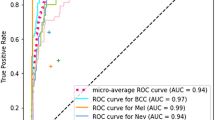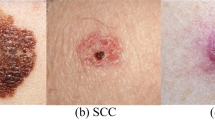Abstract
Identifying melanoma skin cancer accurately and promptly is crucial for successfully applying treatment methods. While helpful, conventional methods often must catch up to the desired accuracy level. This paper presents a pioneering approach to overcome these limitations. The crux of our investigation was assessing the effectiveness of pre-trained deep convolutional neural network (DCNN) models, especially ResNet50, when merged with Thepade sorted block truncation coding (Thepade SBTC) for detecting Melanoma. We aimed to develop and evaluate a feature fusion technique incorporating these methodologies to improve diagnostic accuracy. The research also aimed to compare this newly suggested approach with existing methods, appraise its performance via appropriate metrics, and elucidate the potential advantages and limitations. To realise these objectives, the work proposed here combined the pre-trained DCNN model ResNet50 and Thepade SBTC features. These models were trained and evaluated using the HAM10000 datasets. Subsequently, we combined the features extracted from these models with Thepade SBTC 10-ary features to enhance the machine learning classifiers' discernment abilities. We further fine-tuned the pre-trained models to adapt them explicitly for cancer detection. Interestingly, integrating CNN features and Thepade SBTC 8-ary improved the Random Forest classifier's effectiveness, achieving an accuracy rate of 92.78%. A suite of RandomForest, IBK, and NBTree classifiers combined with CNN features and Thepade SBTC 10-ary yielded an accuracy of 92.35%. The findings indicate that merging ResNet50's deep learning features with Thepade SBTC-ary attributes significantly improves melanoma skin cancer detection, albeit slightly increasing the computational demands for feature extraction. Thus, this study contributes to developing more adept and dependable methods for the early detection and treatment of melanoma skin cancer, signposting a promising direction for further research.




Similar content being viewed by others
Data availability
All the datasets used in experimentation are available online on the internet.
References
Abbas Q, Gul A. Detection and classification of malignant melanoma using deep features of NASNet. SN COMPUT SCI. 2023;4:21. https://doi.org/10.1007/s42979-022-01439-9.
Kaur R, Kaur N. Analysis of melanoma cancer detection techniques. SN COMPUT SCI. 2022;3:93. https://doi.org/10.1007/s42979-021-00955-4.
Thepade SD, Chaudhari PR. Land usage identification with fusion of thepade SBTC and sauvola thresholding features of aerial images using ensemble of machine learning algorithms. Appl Artif Intell. 2021;35(2):154–70. https://doi.org/10.1080/08839514.2020.1842627.
Thepade SD, Dewan JH, Chauhan KH "Fusion of Thepade SBTC and GLCM Features for Improved Rice Leaf Disease Detection," 2022 IEEE North Karnataka Subsection Flagship International Conference (NKCon), Vijaypur, India, 2022, pp. 1-5, doi: https://doi.org/10.1109/NKCon56289.2022.10126582
Thepade SD, Abin D, Chauhan KH "Improved Rice Leaf Disease Detection using Fusion of Otsu Thresholding and Thepade SBTC Features," 2022 International Conference on Recent Trends in Microelectronics, Automation, Computing and Communications Systems (ICMACC), Hyderabad, India, 2022, pp. 1–6, doi: https://doi.org/10.1109/ICMACC54824.2022.10093433.
Reis HC, Turk V, Khoshelham K, Kaya S. InSiNet: a deep convolutional approach to skin cancer detection and segmentation. Med Biol Eng Comput. 2022;60(3):643–62. https://doi.org/10.1007/s11517-021-02473-0.
Lu X, Firoozeh Abolhasani Zadeh YA. Deep learning-based classification for melanoma detection using xceptionnet. J Healthc Eng. 2022. https://doi.org/10.1155/2022/2196096. (PMID: 35360474; PMCID: PMC8964214).
Dildar M, et al. Skin cancer detection: a review using deep learning techniques. Int J Environ Res Public Health. 2021;18(10):5479. https://doi.org/10.3390/ijerph18105479.
Jones OT, Matin RN, van der Schaar M, Prathivadi Bhayankaram K, Ranmuthu CKI, Islam MS, Behiyat D, Boscott R, Calanzani N, Emery J, Williams HC, Walter FM. Artificial intelligence and machine learning algorithms for early detection of skin cancer in the community and primary care settings: a systematic review. Lancet Digit Health. 2022;4(6):e466–76. https://doi.org/10.1016/S2589-7500(22)00023-1. (PMID: 35623799).
Sharma AN, Shwe S, Mesinkovska NA. Current state of machine learning for non-melanoma skin cancer. Arch Dermatol Res. 2022;314(4):325–7. https://doi.org/10.1007/s00403-021-02236-9. (Epub 2021 May 15 PMID: 33991230).
Kim C, Jang M, Han Y, Hong Y, Lee W. Skin lesion classification using hybrid convolutional neural network with edge color, and texture information. Appl Sci. 2023;13(9):5497.
Bozkurt F. Skin lesion classification on dermatoscopic images using effective data augmentation and pre-trained deep learning approach. Multimed Tools Appl. 2023;82(12):18985–9003.
Bardou D, Bouaziz H, Lv L, Zhang T. Hair removal in dermoscopy images using variational autoencoders. Skin Res Technol. 2022;28(3):445–54.
Suiçmez Ç, Kahraman HT, Suiçmez A, Yılmaz C, Balcı F. Detection of melanoma with hybrid learning method by removing hair from dermoscopic images using image processing techniques and wavelet transform. Biomed Signal Process Control. 2023;84:104729.
Sudeep D Thepade, Amruta Aher, S. D. Thepade and A. Aher, "Machine Learning Based Melanoma Skin Cancer Identification Using Feature Fusion of Thepade's TSBTC and Bernsen Thresholding," 2022 International Conference on Signal and Information Processing (IConSIP), Pune, India, 2022, pp. 1–6, doi: https://doi.org/10.1109/ICoNSIP49665.2022.10007471.
Thepade SD, Aher AS, Jadhav SR "Machine Learning-Based Brain Tumor Identification using Fusion of Niblack Thresholding and Thepade SBTC Features,"In: 2022 IEEE 2nd Mysore Sub Section International Conference (MysuruCon), Mysuru, India, 2022, pp. 1-6, doi: https://doi.org/10.1109/MysuruCon55714.2022.9972722
Lima DM, Rodrigues-Jr JF, Brandoli B, et al. DermaDL: advanced convolutional neural networks for computer-aided skin-lesion classification. SN COMPUT SCI. 2021;2:253. https://doi.org/10.1007/s42979-021-0.
Tschandl P. The HAM10000 dataset is a large collection of multi-source dermatoscopic images of common pigmented skin lesions. Harvard Dataverse, 2018, vol 4. https://doi.org/10.7910/DVN/DBW86T. Accessed 10 Apr 2023
Thepade SD, Idhate ME. Machine Learning-Based Scene Classification Using Thepade’s SBTC LBP and GLCM. In: Futuristic Trends in Networks and Computing Technologies Lecture Notes in Electrical Engineering, vol. 936. Singapore: Springer; 2022.
Thepade SD, Adrakatti SS (2023) Identification of Aerial Image Land Use using Fused Thepade SBTC and Adaptive Thresholding with MachineLearning Ensemble. In: 2023 2nd International Conference for Innovation in Technology (INOCON), Bangalore, India, 2023, pp. 1-8, doi: https://doi.org/10.1109/INOCON57975.2023.10101128.
Thepade SD, Bhalerao AP "Machine Learning based Land Use Identification of Aerial Images with Fusion of Thepade SBTC and Triangle Thresholding,"In: 2023 2nd International Conference for Innovation in Technology (INOCON), Bangalore, India, 2023, pp. 1-7, doi: https://doi.org/10.1109/INOCON57975.2023.10101262
Thepade SD, Bafna Y "Improving the Performance of Machine Learning Classifiers for Image Category Identification Using Feature Level Fusion of Otsu Segmentation Augmented with Thepade's N-Ary Sorted Block Truncation Coding,"In: 2018 Fourth International Conference on Computing Communication Control and Automation (ICCUBEA), Pune, India, 2018, pp. 1–6, doi: https://doi.org/10.1109/ICCUBEA.2018.8697440.
Thepade SD, Bhushari A. Improved classification of histopathological images using the feature fusion of Thepade sorted block truncation code and Niblack thresholding. ELCVIA Electron Lett Comput Vis Imag Anal. 2023;22(1):15–31.
Thepade SD, Subhedarpage KS, Mali AA, Vaidya TS "Performance gain of content based video retrieval technique using intermediate block truncation coding on different color spaces, "In: 2013 International Conference on Communication and Signal Processing, Melmaruvathur, India, 2013, pp. 1017–1020, doi: https://doi.org/10.1109/iccsp.2013.6577210
Thepade SD, Kekre HB, Lohar AT. Thepade’s ternary block truncation coding with various degrees and color spaces for content based image retrieval. Int J Emerging Technol Comput Appl Sci. 2013;4(1):49–55.
Madane M. Sudeep Thepade,"score level fusion based bimodal biometric identification using thepade’s sorted n-ary block truncation coding with variod proportions of iris and palmprint traits". Procedia Comput Sci. 2016;79:466–73. https://doi.org/10.1016/j.procs.2016.03.060.
Wikimedia Commons contributors. File:ResNet50.png [Internet]. Wikimedia Commons; 2021 Nov 18, 12:48 UTC. Available from: https://commons.wikimedia.org/w/index.php?title=File:ResNet50.png&oldid=608061849.
Thepade SD, Dindorkar M, Chaudhari P, Bang S. Face presentation attack identification optimisation with adjusting convolution blocks in VGG networks. Intell Syst Appl. 2022;16:200107. https://doi.org/10.1016/j.iswa.2022.200107.
Thepade SD, Jaison JA. Fusion of vectored text descriptors with auto extracted deep CNN features for improved image classification. Intell Syst Appl. 2022;16:200108. https://doi.org/10.1016/j.iswa.2022.200108.
Alwakid G, Gouda W, Humayun M, Sama NU. Melanoma detection using deep learning-based classifications. Healthcare (Basel). 2022;10(12):2481. https://doi.org/10.3390/healthcare10122481. (PMID:36554004;PMCID:PMC9777935).
Mehr RA, Ameri A. Skin cancer detection based on deep learning.". J Biomed Phy Eng. 2022;12(6):559–68. https://doi.org/10.31661/jbpe.v0i0.2207-1517.
Afza F, Sharif M, Mittal M, Khan MA, Jude HD. A hierarchical three-step superpixels and deep learning framework for skin lesion classification. Methods. 2022;202:88–102. https://doi.org/10.1016/j.ymeth.2021.02.013. (Epub 2021 Feb 19 PMID: 33610692).
Thepade SD, Dindorkar MR. Fusing deep convolutional neural network features with Thepade’s SBTC for land usage identification. Eng Sci Technol Int J. 2022;27:101014. https://doi.org/10.1016/j.jestch.2021.05.018.
Kekre HB, Thepade SD, Chopra T. Face and gender recognition using principal component analysis. Int J Comput Sci Eng. 2010;2(4):959–64.
Thepade SD, Yadav SD Assessment of similarity measurement criteria in Thepade's Sorted Ternary Block Truncation Coding (TSTBTC) for Content Based Video Retrieval, In: 2015 International Conference on Communication, Information & Computing Technology (ICCICT), Mumbai, India, 2015, pp. 1–6, doi: https://doi.org/10.1109/ICCICT.2015.7045728.
Thepade SD, Tonge AA An optimized key frame extraction for detection of near duplicates in content based video retrieval, In: 2014 International Conference on Communication and 'Not Applicable' Signal Processing, Melmaruvathur, India, 2014, pp. 1087–1091, doi: https://doi.org/10.1109/ICCSP.2014.6950015'Not Applicable' All the data
Thepade SD, Jadhav K Covid19 Identification from Chest X-Ray Images using Local Binary Patterns with assorted Machine Learning Classifiers, In: 2020 IEEE Bombay Section Signature Conference (IBSSC), Mumbai, India, 2020, pp. 46-51, doi: https://doi.org/10.1109/IBSSC51096.2020.9332158
Shinde SR, Thepade SD "Gender classification with KNN by extraction of Haar wavelet features from canny shape fingerprints," In: 2015 International Conference on Information Processing (ICIP), Pune, India, 2015, pp. 702–707, doi: https://doi.org/10.1109/INFOP.2015.7489473
Funding
No funding received so Not Applicable.
Author information
Authors and Affiliations
Contributions
Idea and Concept of Sudeep D. Thepade. Both authors have equally contributed in the work of experimentation drafting and analysis.
Corresponding author
Ethics declarations
Conflict of interest
Not Applicable.
Research Involving Human and /or Animals
Not Applicable
Informed Consent
The work can be used further for educational purposes with proper citation.
Additional information
Publisher's Note
Springer Nature remains neutral with regard to jurisdictional claims in published maps and institutional affiliations.
Rights and permissions
Springer Nature or its licensor (e.g. a society or other partner) holds exclusive rights to this article under a publishing agreement with the author(s) or other rightsholder(s); author self-archiving of the accepted manuscript version of this article is solely governed by the terms of such publishing agreement and applicable law.
About this article
Cite this article
Thepade, S.D., Shukla, S. Enhancing Melanoma Skin Cancer Detection Through Feature Fusion of Pre-Trained Deep Convolutional Neural Network ResNet50 and Thepade Sorted Block Truncation Coding. SN COMPUT. SCI. 5, 426 (2024). https://doi.org/10.1007/s42979-024-02821-5
Received:
Accepted:
Published:
DOI: https://doi.org/10.1007/s42979-024-02821-5




